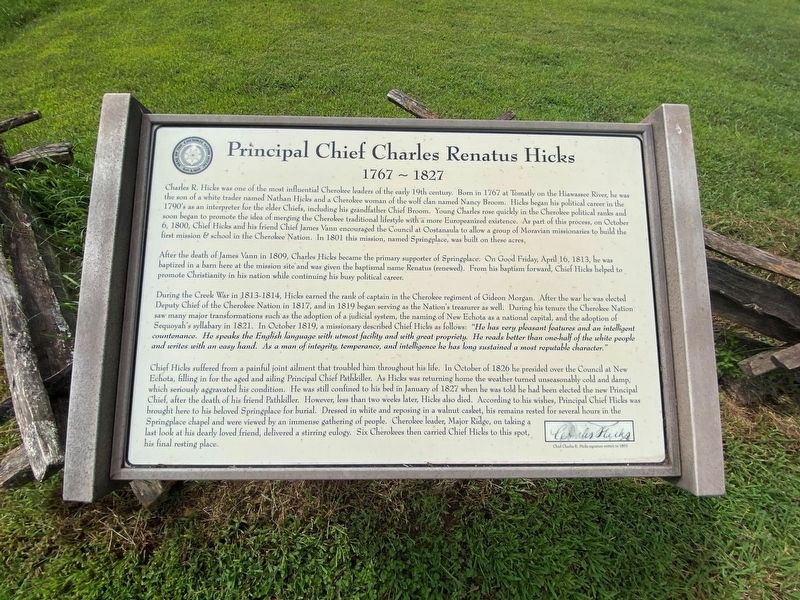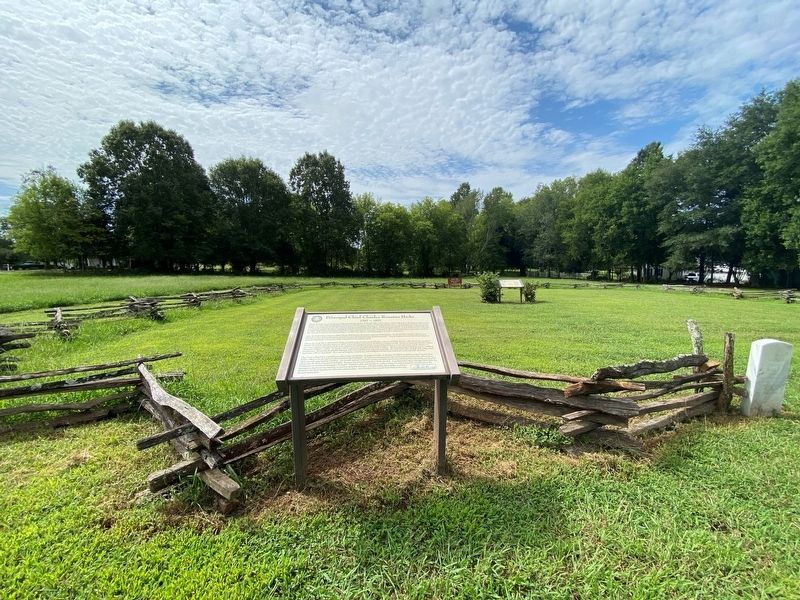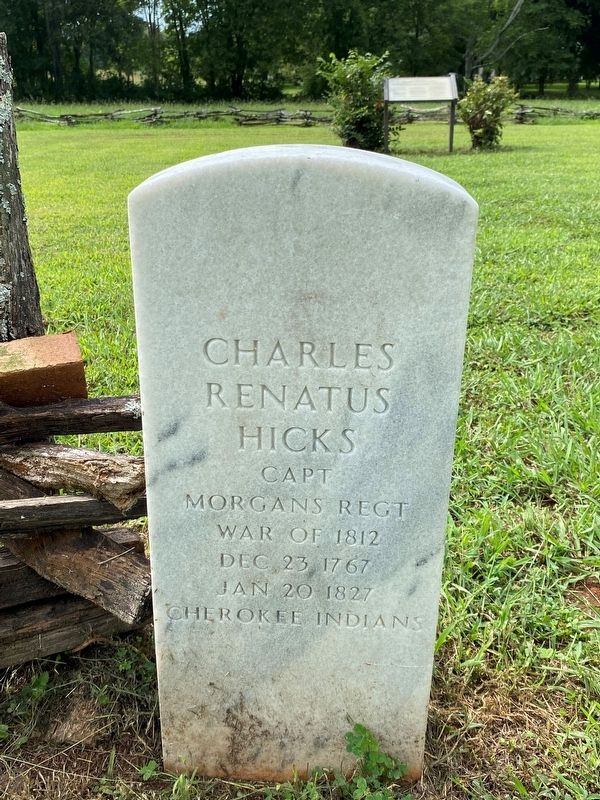Chatsworth in Murray County, Georgia — The American South (South Atlantic)
Principal Chief Charles Renatus Hicks
1767 - 1827
Inscription.
Charles R. Hicks was one of the most influential Cherokee leaders of the early 19th century. Born in 1767 at Tomatly on the Hiawassee River, he was the son of a white trader named Nathan Hicks and a Cherokee woman of the wolf clan named Nancy Broom. Hicks began his political career in the 1790's as an interpreter for the elder Chiefs, including his grandfather Chief Broom. Young Charles rose quickly in the Cherokee political ranks and soon began to promote the idea of merging the Cherokee traditional lifestyle with a more Europeanized existence. As part of this process, on October 6, 1800, Chief Hicks and his friend Chief James Vann encouraged the Council at Oostanaula to allow a group of Moravian missionaries to build the first mission & school in the Cherokee Nation. In 1801 this mission, named Springplace, was built on these acres.
After the death of James Vann in 1809, Charles Hicks became the primary supporter of Springplace. On Good Friday, April 16, 1813, he was baptized in a barn here at the mission site and was given the baptismal name Renatus (renewed). From his baptism forward, Chief Hicks helped promote Christianity in his nation while continuing his busy political career.
During the Creek War in 1813-1814, Hicks earned the rank of captain in the Cherokee regiment of Gideon Morgan. After the war he was elected Deputy Chief of the Cherokee Nation in 1817, and in 1819 began serving as the Nation's treasurer as well. During his tenure the Cherokee Nation saw many major transformations such as the adoption of a judicial system, the naming of New Echota as a national capital, and the adoption of Sequoyah's syllabary in 1821. In October 1819, a missionary described Chief Hicks as follows: "He has very pleasant features and an intelligent countenance. He speaks the English language with utmost facility and with great propriety. He reads better than one-half of the white people and writes with an easy hand. As a man of integrity, temperance, and intelligence he has long sustained a most reputable character."
Chief Hicks suffered from a painful joint ailment that troubled him throughout his life. In October of 1826 he presided over the Council at New Echota, filling in for the aged and ailing Principal Chief Pathkiller. As Hicks was returning home the weather turned unseasonably cold and damp, which seriously aggravated his condition. He was still confined to his bed in January of 1827 when he was told he had been elected the new Principal Chief, after the death of his friend Pathkiller. However, less than two weeks later, Hicks also died. According to his wishes, Principal Chief Hicks was brought here to his beloved Springplace for burial. Dressed in white and reposing
in a walnut casket, his remains rested for several hours in the Springplace chapel and were viewed by an immense gathering of people. Cherokee leader, Major Ridge, on taking a last look at his dearly loved friend, delivered a stirring eulogy. Six Cherokees then carried Chief Hicks to this spot, his final resting place.
(caption)
Chief Charles R. Hicks signature written in 1803
Topics. This historical marker is listed in these topic lists: Cemeteries & Burial Sites • Churches & Religion • Education • Native Americans. A significant historical date for this entry is October 6, 1800.
Location. 34° 45.669′ N, 84° 48.964′ W. Marker is in Chatsworth, Georgia, in Murray County. Marker can be reached from the intersection of Georgia Route 52 and Ellijay Street, on the left when traveling west. Touch for map. Marker is at or near this postal address: 109 Ellijay St, Chatsworth GA 30705, United States of America. Touch for directions.
Other nearby markers. At least 8 other markers are within walking distance of this marker. Springplace Mission (a few steps from this marker); Anna Rosina Kliest Gambold (a few steps from this marker); "God's Acre" (a few steps from this marker); The Moravian Mission to the Cherokee Indians (a few steps from this marker); Springplace Moravian Mission & School (within shouting distance of this marker); Old Federal Road
(approx. 0.3 miles away); John Howard Payne (approx. 0.4 miles away); Chief Vann House (approx. 0.4 miles away). Touch for a list and map of all markers in Chatsworth.
Credits. This page was last revised on September 20, 2021. It was originally submitted on September 20, 2021, by Darren Jefferson Clay of Duluth, Georgia. This page has been viewed 1,547 times since then and 250 times this year. Photos: 1, 2, 3. submitted on September 20, 2021, by Darren Jefferson Clay of Duluth, Georgia. • Bernard Fisher was the editor who published this page.


